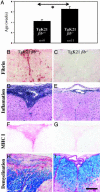Fibrin depletion decreases inflammation and delays the onset of demyelination in a tumor necrosis factor transgenic mouse model for multiple sclerosis
- PMID: 15096619
- PMCID: PMC404108
- DOI: 10.1073/pnas.0303859101
Fibrin depletion decreases inflammation and delays the onset of demyelination in a tumor necrosis factor transgenic mouse model for multiple sclerosis
Abstract
In multiple sclerosis, in which brain tissue becomes permeable to blood proteins, extravascular fibrin deposition correlates with sites of inflammatory demyelination and axonal damage. To examine the role of fibrin in neuroinflammatory demyelination, we depleted fibrin in two tumor necrosis factor transgenic mouse models of multiple sclerosis, transgenic lines TgK21 and Tg6074. In a genetic analysis, we crossed TgK21 mice into a fibrin-deficient background. TgK21fib(-/-) mice had decreased inflammation and expression of major histocompatibility complex class I antigens, reduced demyelination, and a lengthened lifespan compared with TgK21 mice. In a pharmacologic analysis, fibrin depletion, by using the snake venom ancrod, in Tg6074 mice also delayed the onset of inflammatory demyelination. Overall, these results indicate that fibrin regulates the inflammatory response in neuroinflammatory diseases. Design of therapeutic strategies based on fibrin depletion could potentially benefit the clinical course of demyelinating diseases such as multiple sclerosis.
Figures





References
Publication types
MeSH terms
Substances
Grants and funding
LinkOut - more resources
Full Text Sources
Other Literature Sources
Medical
Molecular Biology Databases

